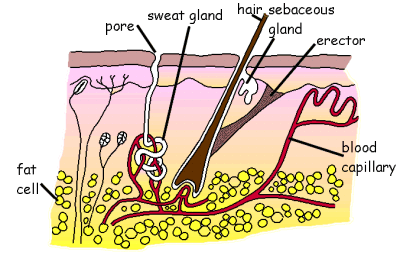Mechanisms of Temperature Control
When our body is too warm we must be able to cool ourselves. When we are too cold we must be able to warm ourselves. Our body has a number of mechanisms which can be used to do this.
Since we lose our heat through the skin, it is not surprising that many of the thermoregulatory mechanisms are found here. Blood transports heat around the body and so is involved also.

What happens when we are too warm.
The blood vessels close to the surface of our skin open up more to allow a greater volume of blood to pass through. As the blood flows near to the surface of the skin, heat is lost by radiation to the surroundings. This makes the skin look redder. This is known as vaso-dilation.
The sweat glands release sweat. As the water in sweat evaporates it takes with it energy, leaving the body cooler.
What happens when we are too cold.
We not not sweat. The blood vessels which run close to the surface of the skin constrict, which reduces the amount of blood flowing near to the skin and so reduces the amount of so reduces heat lost by radiation. This is known as vaso-constrictionThe hairs on the skin stand upright, to trap air (an insulator) close to our body (This is not as effective in humans as it is in hairier mammals as we have less hair). This makes it harder for heat to be lost.
If we are really cold then we need to warm ourselves up. This is done by making our muscles twitch when we shiver. This makes our muscles respire more. Some of the energy released in respiration is heat. This warms up the body. The liver can also respire more to generate more heat.
